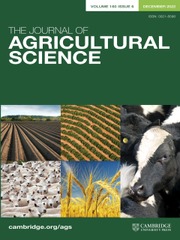Article contents
A statistical method to standardize and interpret the activity data generated by wireless biosensors in dairy cows
Published online by Cambridge University Press: 23 November 2023
Abstract
Activity biosensors have been used recently to measure and diagnose the physiological status of dairy cows. However, owing to the variety of commercialized activity biosensors available in the market, activity data generated by a biosensor need to be standardized to predict the status of an animal and make relevant decisions. Hence, the objective of this study was to develop a standardization method for accommodating activity measurements from different sensors. Twelve Holstein dairy cows were monitored to collect 12 862 activity data from four types of sensors over five months. After confirming similar cyclic activity patterns from the sensors through correlation and regression analyses, the gamma distribution was employed to calculate the cumulative probability of the values of each biosensor. Then, the activity values were assigned to three levels (i.e., idle, normal and active) based on the defined proportion of each level, and the values at each level from the four sensors were compared. The results showed that the number of measurements belonging to the same level was similar, with less than a 10% difference at a specific threshold value. In addition, more than 87% of the heat alerts generated by the internal algorithm of three of the four biosensors could be assigned to the active level, suggesting that the current standardization method successfully integrated the activity measurements from different biosensors. The developed probability-based standardization method is expected to be applicable to other biosensors for livestock, which will lead to the development of models and solutions for precision livestock farming.
Information
- Type
- Modelling Animal Systems Research Paper
- Information
- Copyright
- Copyright © The Author(s), 2023. Published by Cambridge University Press
Footnotes
Both authors equally contributed to this work as the first author.
References
- 3
- Cited by


